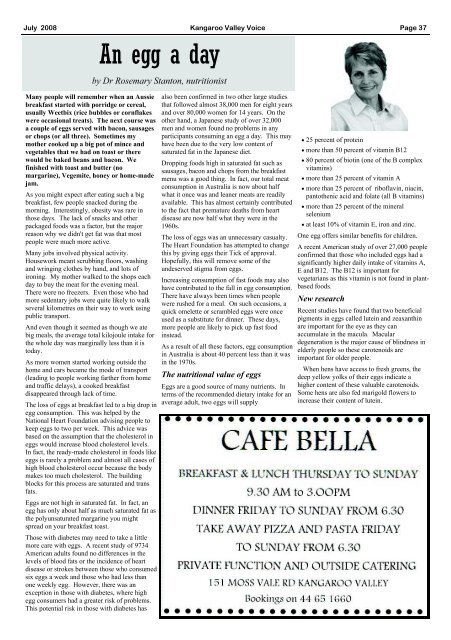Kangaroo Valley Voice - Lazyfish Technology
Kangaroo Valley Voice - Lazyfish Technology
Kangaroo Valley Voice - Lazyfish Technology
Create successful ePaper yourself
Turn your PDF publications into a flip-book with our unique Google optimized e-Paper software.
July 2008 <strong>Kangaroo</strong> <strong>Valley</strong> <strong>Voice</strong> Page 37An egg a dayMany people will remember when an Aussiebreakfast started with porridge or cereal,usually Weetbix (rice bubbles or cornflakeswere occasional treats). The next course wasa couple of eggs served with bacon, sausagesor chops (or all three). Sometimes mymother cooked up a big pot of mince andvegetables that we had on toast or therewould be baked beans and bacon. Wefinished with toast and butter (nomargarine), Vegemite, honey or home-madejam.As you might expect after eating such a bigbreakfast, few people snacked during themorning. Interestingly, obesity was rare inthose days. The lack of snacks and otherpackaged foods was a factor, but the majorreason why we didn't get fat was that mostpeople were much more active.Many jobs involved physical activity.Housework meant scrubbing floors, washingand wringing clothes by hand, and lots ofironing. My mother walked to the shops eachday to buy the meat for the evening meal.There were no freezers. Even those who hadmore sedentary jobs were quite likely to walkseveral kilometres on their way to work usingpublic transport.And even though it seemed as though we atebig meals, the average total kilojoule intake forthe whole day was marginally less than it istoday.As more women started working outside thehome and cars became the mode of transport(leading to people working farther from homeand traffic delays), a cooked breakfastdisappeared through lack of time.The loss of eggs at breakfast led to a big drop inegg consumption. This was helped by theNational Heart Foundation advising people tokeep eggs to two per week. This advice wasbased on the assumption that the cholesterol ineggs would increase blood cholesterol levels.In fact, the ready-made cholesterol in foods likeeggs is rarely a problem and almost all cases ofhigh blood cholesterol occur because the bodymakes too much cholesterol. The buildingblocks for this process are saturated and transfats.Eggs are not high in saturated fat. In fact, anegg has only about half as much saturated fat asthe polyunsaturated margarine you mightspread on your breakfast toast.Those with diabetes may need to take a littlemore care with eggs. A recent study of 9734American adults found no differences in thelevels of blood fats or the incidence of heartdisease or strokes between those who consumedsix eggs a week and those who had less thanone weekly egg. However, there was anexception in those with diabetes, where highegg consumers had a greater risk of problems.This potential risk in those with diabetes hasby Dr Rosemary Stanton, nutritionistalso been confirmed in two other large studiesthat followed almost 38,000 men for eight yearsand over 80,000 women for 14 years. On theother hand, a Japanese study of over 32,000men and women found no problems in anyparticipants consuming an egg a day. This mayhave been due to the very low content ofsaturated fat in the Japanese diet.Dropping foods high in saturated fat such assausages, bacon and chops from the breakfastmenu was a good thing. In fact, our total meatconsumption in Australia is now about halfwhat it once was and leaner meats are readilyavailable. This has almost certainly contributedto the fact that premature deaths from heartdisease are now half what they were in the1960s.The loss of eggs was an unnecessary casualty.The Heart Foundation has attempted to changethis by giving eggs their Tick of approval.Hopefully, this will remove some of theundeserved stigma from eggs.Increasing consumption of fast foods may alsohave contributed to the fall in egg consumption.There have always been times when peoplewere rushed for a meal. On such occasions, aquick omelette or scrambled eggs were onceused as a substitute for dinner. These days,more people are likely to pick up fast foodinstead.As a result of all these factors, egg consumptionin Australia is about 40 percent less than it wasin the 1970s.The nutritional value of eggsEggs are a good source of many nutrients. Interms of the recommended dietary intake for anaverage adult, two eggs will supply25 percent of proteinmore than 50 percent of vitamin B1280 percent of biotin (one of the B complexvitamins)more than 25 percent of vitamin Amore than 25 percent of riboflavin, niacin,pantothenic acid and folate (all B vitamins)more than 25 percent of the mineralseleniumat least 10% of vitamin E, iron and zinc.One egg offers similar benefits for children.A recent American study of over 27,000 peopleconfirmed that those who included eggs had asignificantly higher daily intake of vitamins A,E and B12. The B12 is important forvegetarians as this vitamin is not found in plantbasedfoods.New researchRecent studies have found that two beneficialpigments in eggs called lutein and zeaxanthinare important for the eye as they canaccumulate in the macula. Maculardegeneration is the major cause of blindness inelderly people so these carotenoids areimportant for older people.When hens have access to fresh greens, thedeep yellow yolks of their eggs indicate ahigher content of these valuable carotenoids.Some hens are also fed marigold flowers toincrease their content of lutein.
















